Prehistoric archaeology
This article needs additional citations for verification. (February 2015) |
Prehistoric archaeology is a subfield of
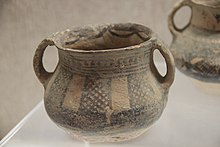
Due to the unique nature of prehistoric archaeology, in that written records can not be drawn upon to aid the study of the societies it focuses on, the subject matter investigated is entirely material remains as they are the only traceable evidence that is available. Material evidence includes pottery, burial goods, the remains of individuals and animals such as bones, jewellery and decorative items as well as many other artefacts. The subfield has existed since at least the late 1820s or early 1830s [3] and is now a fully recognised and separate field of archaeology. Other fields of archaeology include; Classical archaeology, Near Eastern archaeology - as known as Biblical archaeology, Historical archaeology, Underwater archaeology and many more, each working to reconstruct our understanding of everything from the ancient past right up until modern times. Unlike continent and area specific fields of archaeology such as; Classical - which studies specifically the Mediterranean region and the civilisations of Ancient Greece and Ancient Rome in antiquity, the field of prehistoric archaeology is not contained to one continent. As such, there are many excavations attributed to this field which have occurred and are occurring all over the world to uncover all different types of settlements and civilisations.
Without history to provide evidence for names, places and motivations, prehistoric archaeologists speak in terms of cultures which can only be given arbitrary modern names relating to the locations of known occupation sites or the artifacts used. It is naturally much easier to discuss societies rather than individuals as these past people are completely anonymous in the archaeological record. Such a lack of concrete information means that prehistoric archaeology is a contentious field and the arguments that range over it have done much to inform archaeological theory.[4]
Origins
Prehistoric archaeology, as with many other fields of archaeology, is attributed to multiple different individuals therefore an accurate and definitive timeline for its creation is difficult to present. The origins of prehistoric archaeology were marked by treasure hunting also known as
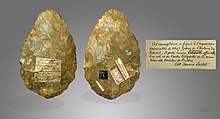
Beyond that, there are three other individuals who represented different field schools who are thought to have begun the first excavations dedicated solely to the study of prehistoric archaeology at roughly the same time between the 1820s to 1830s.
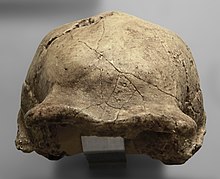
Outside of these individuals, each continent began to host excavations and field schools to explore their own prehistory across a wide spectrum of dates. Several examples, though not a complete list of every country, are listed below by continental area. Within Europe exploration began in England with several individuals such as amateur archaeologist
Purpose
The purpose of prehistoric archaeology is to explore and understand civilisations that existed before writing systems; including the Stone, Bronze and Iron Age societies across the world. Within its early origins prehistoric archaeology had a focus on gathering artefacts and treasures to display in museums and private collections often to bring wealth back for the individual. Later on the field allowed for the more legitimate study of material evidence and data in order to ascertain important details such as; when the site may have been occupied, who was living there, what activities they may have engaged in, and finally what happened to them to either cause them to leave or make the area uninhabitable.
Notable Archaeologists

There are multitudes of credible past and emerging prehistoric archaeologists who have dedicated time and effort into honing their craft in order to accurately understand the lives of the individuals and societies they are studying. Some of the important foundational archaeologists are; Daniel Wilson – a Scottish-born Canadian archaeologist who first brought the term prehistoric into an archaeological context, Paul Tournal – a French amateur archaeologist,
More modern archaeologists, including Ali Umut Türkcan – who directed the excavations at
Main types and locations of sites

Some of the main types of sites include early
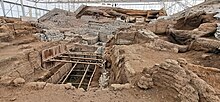
Prehistoric settlements are scattered all over the world, they vary in age and size. The period in which prehistoric archaeology covers is most often the
Methods of investigation and analysis
Archaeologists use many different methods to research the artefacts and materials that may be found during an excavation. Within early excavations dedicated to treasure hunting little to no care was taken when removing soil covering artefacts or when removing the artefacts and materials themselves from sites which may have led to the destruction of materials and has placed some recovered artefacts at risk. Often the digs were conducted by amateurs and treasure hunters who did not have the knowledge we do now about how to remove artefacts safely. Some of the main techniques used to gently recover artefacts or to ensure the integrity of the site remains for future exploration and the preservation of the site are;
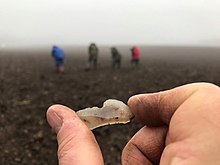
Within aerial photography several important markers of archaeological sites can be revealed such as; shadow marks, crop marks and soil marks.[32] Archaeologists also use a range of techniques when excavating a site to uncover materials including; digging test pits, creating trenches and using the box-grid or quadrant method to keep track of different areas of the site.[32]
Some of the technology used to assist in looking for and uncovering materials in prehistoric archaeological sites are; electrical resistivity meters – which help locate objects underground non-disruptively, laser theodolites – to help map the site layout, satellite survey - which uses satellites to get an aerial view of the site, lidar - which uses lasers to scan for objects underground and sonar - which uses soundwaves to scan the earth for objects.[33][32] None of these techniques are solely practised within prehistoric archaeology, most archaeological techniques may be used across many of the different subfields of archaeology.
Issues in the field
There are a vast amount of difficulties faced within prehistoric archaeology including; site degradation,
Other issues within the field of prehistoric archaeology which also affect every other branch of archaeology is the ethics[36] of removing artefacts and or storing finds in museums. This moral question is a delicate balance within prehistoric archaeology as all finds and bodies must be treated with respect but archaeologists also wish to study them in order to further their understanding of the different origins of humanity.
References
- ^ "Archaeology Defined". Institute for Field Research. Retrieved 30 March 2022.
- ^ OCLC 35178577.
- ^
- ISSN 1131-6993. Retrieved 2 October 2018.
- S2CID 7812572
- ISBN 9781139481380.
- ^ Eddy, Matthew (2011), "The prehistoric mind as a historical artefact", The Royal Society Journal of the History of Science, 65: 1–8
- ^ S2CID 112422270
- ^ doi:10.5334/bha.242
- ^ a b "Jens Jacob Asmussen Worsaae". Oxford Reference. 2022. Retrieved April 28, 2022.
- ^ S2CID 210276670
- .
- ^ a b McFarlane, Donald A.; Lundberg, Joyce (2005), "The 19th Century excavation of Kent's Cavern, England", Journal of Cave and Karst Studies, 67: 39–47
- S2CID 245264809
- ^ Archaeology and the study of Ancient China, Asian Art Museum, retrieved 28 April 2022
- JSTOR 3014449
- ^ Stein, Britta (2018). History of Archaeology in Japan. Smith C. (eds) Encyclopedia of Global Archaeology. Springer.
- ^ Boriskovsky, P (1866), "Basic Problems of the Prehistoric Archaeology of Vietnam", Asian Perspectives, 9: 83–85
- ^ Smith, Claire (2007). Digging it up in Down Under. World Archaeological Congress Cultural Heritage Manual Series. Springer.
- ^ "Public Archeology in the United States - A Timeline". Retrieved 28 April 2022.
- S2CID 163418336
- S2CID 128406453
- JSTOR 204180
- ^ Potts, Daniel T. "The History of Archaeological Research in Iran: A Brief Survey". Retrieved 28 April 2022.
- .
- ^ Bilge, Kucukdogan. "Current excavations at Çatalhöyük". Retrieved 30 March 2022.
- ^ ISBN 9780415526883.
- ^ "Roman England, the Roman in Britain 43 - 410 AD". Historic UK. Retrieved 2019-03-07.
- ISSN 0003-5815.
- ^ "Egypt in the Third Intermediate Period (ca. 1070–664 B.C.)". www.metmuseum.org. Retrieved 2019-03-07.
- ^ a b Frost, Randell. "Excavation Methods". Retrieved 28 April 2022.
- ^ ISBN 9780415526883.
- ^ Frost, Randell. "Excavation Methods". Retrieved 28 April 2022.
- JSTOR 2798577.
- S2CID 147568983.
- S2CID 149684996.
